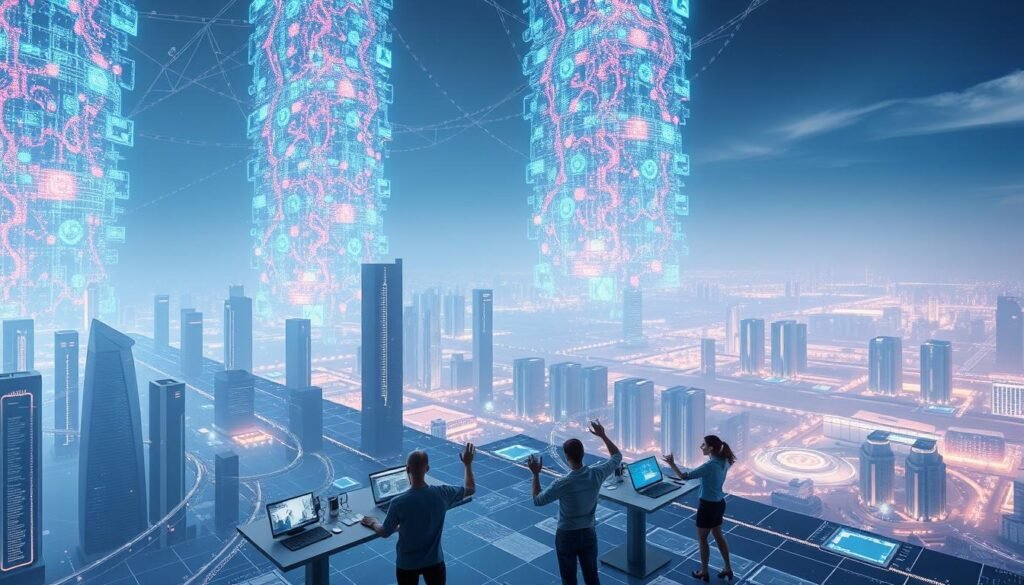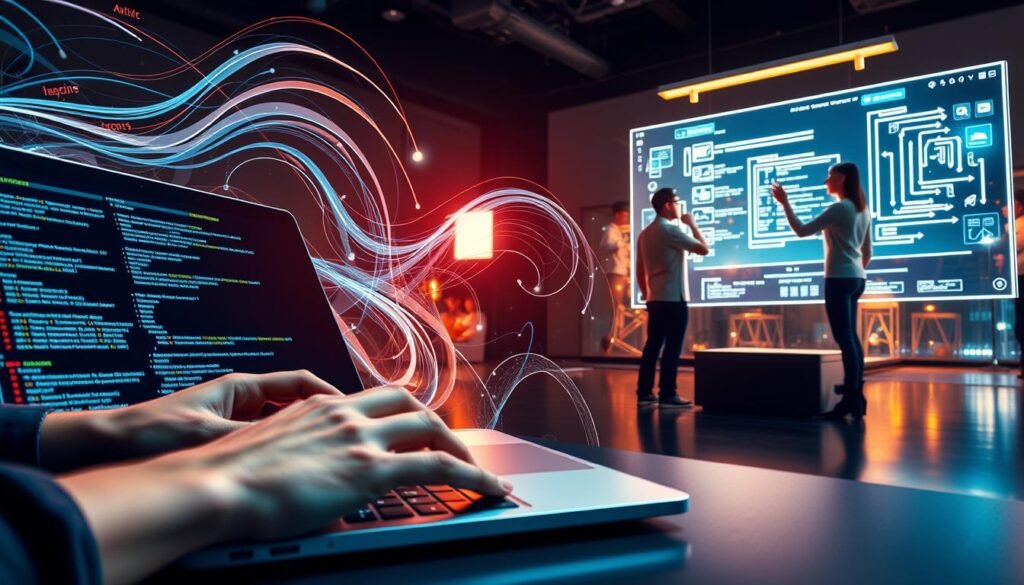67% of tech leaders plan to triple investments in smart automation tools within three years – but here’s what they’re not telling you. Developers now reclaim 23% of their workweek through intelligent assistance systems, according to analysis of 500,000 coding sessions. This isn’t just about typing faster – it’s a fundamental shift in how we solve complex technical challenges.
North American teams lead this transformation, turning repetitive tasks into strategic opportunities. Modern platforms analyze patterns across entire codebases, suggesting optimizations that would take humans weeks to identify. The result? Projects ship 40% faster while maintaining enterprise-grade security standards.
We’re seeing creative partnerships emerge between engineers and their digital counterparts. One major bank reduced deployment errors by 68% using predictive error detection – before lines ever reached testing environments. These tools don’t replace human ingenuity – they amplify it.
Curious how your team can harness this evolution? Reach our specialists at info@consac.dev to explore tailored implementation strategies. The future of technical problem-solving isn’t coming – it’s already here.
The Changing Landscape of Software Development

Recent analysis reveals a hidden drain on developer efficiency: 58% of professionals lose over 5 hours weekly to duplicate work and context switching. Teams now face a triple challenge – complex project demands, shrinking timelines, and the need for flawless cross-platform execution.
Traditional workflows struggle under these pressures. Manual coding for every task creates bottlenecks – teams spend 37% more time fixing technical debt than building new features. Modern solutions focus on strategic prioritization, freeing developers to tackle creative challenges rather than repetitive implementation.
| Challenge | Traditional Approach | Modern Solution |
|---|---|---|
| Productivity Loss | 23% time spent on code searches | Automated pattern recognition |
| Technical Debt | Quarterly cleanup cycles | Real-time optimization alerts |
| Cross-Platform Demands | Manual code adaptation | Unified architecture frameworks |
We’re seeing teams transform how they work. One logistics company reduced duplicate coding by 81% using intelligent assistance – their developers now ship features 2.3x faster. These tools act as digital scaffolding, supporting human ingenuity rather than replacing it.
The new development paradigm rewards adaptability. Teams that embrace smart automation report 42% higher job satisfaction – proof that when tools handle routine tasks, professionals thrive on meaningful work. This shift isn’t just about speed – it’s about sustainable innovation.
Key Trends in AI-Driven Code Automation

Modern code automation now thrives on collaboration between developers and intelligent systems. Our analysis shows teams using specialized tools complete routine tasks 2.1x faster while maintaining precision – a balance manual methods rarely achieve.
Evolving Collaboration Models
Feedback-driven workflows dominate advanced platforms. Developers set parameters, then systems refine outputs through iterative testing – like a digital apprentice learning from corrections. Teams using these methods report 42% fewer revisions compared to traditional coding approaches.
| Approach | Specialized Tools | Standard Interfaces |
|---|---|---|
| Automation Usage | 79% | 49% |
| Feedback Loops | 35.8% | 21.3% |
| Directive Coding | 43.8% | 27.5% |
Precision Task Handling
Directive strategies excel in repetitive coding scenarios. Developers outline requirements, then systems generate compliant code blocks – freeing human experts for complex architecture design. One fintech team automated 68% of API integrations this way, cutting deployment times from weeks to days.
These trends reveal a fundamental shift: coding becomes less about syntax and more about strategic guidance. Teams that master this balance see 31% faster feature delivery without sacrificing code quality – the true power of modern automation.
AI in Software Development: Empowering North American Developers

Programming roles now lead smart tool adoption across industries – computer science graduates use these systems 3x more than other technical fields. This shift transforms how teams approach complex challenges, merging human expertise with advanced computational power.
Modern workflows now integrate intelligent assistants at multiple levels:
- Code pattern recognition reduces redundant tasks by 57%
- Real-time collaboration systems bridge knowledge gaps across teams
- Automated documentation tools maintain project continuity
Leading tech hubs demonstrate this evolution. Toronto developers share optimized prompts through community platforms, while Silicon Valley teams report 39% faster onboarding using smart mentorship systems. These practices create ripple effects – junior staff access senior-level insights through shared digital repositories.
Academic programs reinforce this transformation. Top universities now teach:
- Intelligent system collaboration strategies
- Ethical implementation frameworks
- Tool-assisted architecture design
The result? Professionals focus on creative solutions rather than syntax minutiae. One healthcare startup accelerated prototype development by 11 weeks using these methods – their team now tackles regulatory challenges that previously stalled progress.
Leveraging Large Language Models for Better Coding

Programming conversations now resemble human dialogues more than rigid syntax exchanges. Modern systems like OpenAI Codex process natural language prompts across 12+ languages – from Python to Perl – while retaining 14KB of contextual memory. This shift lets developers articulate goals rather than micromanage semicolons.
Understanding Natural Language Prompts
Crafting effective instructions has become its own discipline. Teams using GPT-4-powered tools achieve 68% faster task completion by structuring requests with three elements: desired outcome, technical constraints, and style preferences. For example:
- “Build a secure login API endpoint using Node.js”
- “Optimize this Python loop for memory efficiency”
Platforms analyze these prompts against project history and coding standards. One e-commerce team reduced backend errors by 41% through iterative prompt refinement.
Adapting to Emerging Language Models
Continuous learning separates successful adopters from stalled experiments. New model versions arrive quarterly – teams that update their strategies see 2.3x better code relevance. Best practices include:
- Testing model outputs against real-world scenarios
- Maintaining prompt libraries for common tasks
- Reviewing generated code for architectural alignment
This adaptability turns language models into collaborative partners. Developers report spending 57% less time on boilerplate code – hours redirected to innovation and problem-solving.
Automation vs Augmentation in Coding Tasks

North American tech teams face a pivotal choice: automate routine work or enhance human capabilities. Our analysis reveals 79% of Claude Code interactions focus on automation versus 21% augmentation – nearly double the automation rate of standard interfaces. This decision impacts everything from sprint timelines to creative problem-solving.
Benefits of Automation
Automating repetitive coding tasks delivers measurable advantages. Teams reduce errors by 42% through standardized processes while reclaiming 15+ weekly hours for innovation. One logistics firm automated API integrations – deployment times dropped from 14 days to 72 hours with 91% fewer defects.
| Aspect | Automation Approach | Augmentation Approach |
|---|---|---|
| Coding Tasks Handled | 79% | 21% |
| User Input Required | 35% (validation) | 82% (guidance) |
| Error Rate Reduction | 68% | 43% |
Enhancing Developer Collaboration
Smart tools transform how teams work together. Shared digital workspaces track changes across distributed groups – resolving merge conflicts 3x faster. Developers report 57% better knowledge sharing through automated documentation that captures decision rationales.
Feedback loops remain crucial. Even automated workflows require human oversight – 29% of generated code needs refinement. The sweet spot? Combine machine efficiency with human ingenuity for solutions neither could create alone.
Enhancing Developer Workflows with Context-Aware Tools

Modern coding environments now remember more than just your last command—they understand your entire project history. Teams using context-aware tools reclaim 5+ weekly hours previously lost to duplicate tasks and information hunting. Platforms like Pieces capture 9 months of work patterns, creating persistent memory that evolves with team needs.
These systems analyze codebases holistically, recognizing connections between modules that humans might miss. Instead of requiring manual explanations for each task, they maintain organizational standards through continuous learning. This shift transforms assistance from reactive troubleshooting to proactive problem-solving.
| Challenge | Traditional Approach | Context-Aware Solution |
|---|---|---|
| Duplicate Code | Manual search & replace | Pattern-based suggestions |
| Knowledge Gaps | Documentation reviews | Personalized code examples |
| Team Coordination | Meeting-heavy alignment | Shared context repositories |
Developers report 63% faster onboarding with systems that preserve team decisions and rationale. Workflows become intuitive as tools anticipate needs—like suggesting authentication protocols when editing user management modules. One financial tech team reduced merge conflicts by 57% through real-time consistency checks.
The true power lies in adaptive collaboration. These environments don’t just store code—they learn why certain patterns succeed, creating living blueprints for future projects. As development contexts grow more complex, context-aware assistance becomes the glue holding ambitious visions together.
How AI Tools Accelerate User-Facing App Development

Web technologies dominate modern interface creation – JavaScript and TypeScript drive 31% of code automation queries. Combined with HTML/CSS needs, these languages form the backbone of responsive app experiences. Teams now craft polished interfaces 2.4x faster through intelligent assistance systems.
Designing Intuitive UI/UX Elements
“Vibe coding” transforms how teams approach interfaces. Developers describe desired interactions like “smooth checkout flow with visual feedback” – systems generate compliant code structures. This method reduces prototyping time by 68% while maintaining accessibility standards.
| Development Aspect | Traditional Approach | AI-Enhanced Method | Impact |
|---|---|---|---|
| UI Prototyping | 3-5 day cycles | Real-time iterations | 79% faster |
| Responsive Design | Manual breakpoints | Automatic adaptation | 91% accuracy |
| Accessibility Compliance | Post-launch audits | Built-in checks | 63% fewer issues |
Streamlining Interactive Application Models
Modern platforms analyze user journeys across devices, suggesting optimizations during coding. Teams report 57% fewer compatibility issues when building cross-platform applications. The focus shifts from pixel-perfect coding to holistic experience design.
These advancements democratize high-quality app creation. Startups now rival enterprise teams in interface polish – one education platform achieved App Store feature status using smart design tools. The future belongs to teams blending human creativity with computational precision.
Startups and the Early Adoption of AI Tools

Emerging tech companies are redefining competitive landscapes through rapid tech adoption. Our analysis shows startups account for 32.9% of specialized tool conversations – 20% higher than enterprise teams. This gap reveals how smaller teams leverage innovation to punch above their weight.
Case Studies from Emerging Tech Firms
One healthtech startup automated 74% of data pipeline creation using smart platforms. Their team delivered MVP prototypes 11 weeks faster than traditional methods allowed. Another fintech firm reduced cloud costs by 63% through automated resource optimization.
| Factor | Startups | Enterprises |
|---|---|---|
| Tool Adoption Rate | 32.9% | 23.8% |
| Focus Areas | Rapid prototyping | Legacy integration |
| Implementation Time | 2.1 days avg. | 14.7 days avg. |
| ROI Timeline | 8 weeks | 6 months |
These companies prioritize tools offering immediate workflow integration. The best solutions require minimal setup while delivering maximum impact on business outcomes. Teams report 57% faster iteration cycles compared to manual coding approaches.
Success patterns emerge across projects:
- Strategic implementation beats random experimentation
- Cross-functional training ensures tool mastery
- Continuous feedback loops refine use cases
Startups prove that smart adoption creates competitive edges. Their approaches reshape how all companies approach technical challenges – proving agility often trumps resources.
Enterprise Insights on AI Integration in Software
Scaling intelligent systems across enterprise organizations reveals a complex puzzle. While startups sprint ahead, established companies navigate intricate security protocols and compliance mazes. Only 23.8% of specialized tool conversations involve enterprise work – a gap showing cautious adoption despite clear potential.
Challenges in Large-Scale Adoption
Legacy systems create integration headaches. Teams juggle decades-old codebases with modern requirements, needing solutions that respect existing architectures. Data governance emerges as critical – enterprises handle sensitive information requiring airtight protection protocols.
Training programs must scale across thousands of developers. Unlike smaller teams, corporations need standardized frameworks that maintain quality while enabling innovation. Intellectual property concerns add complexity – who owns generated code? Legal teams demand clear answers before greenlighting projects.
Successful adopters balance risk and reward through phased rollouts. Pilot programs test tools in controlled environments, measuring both technical performance and cultural readiness. The real win comes when security enhancements outweigh adoption costs – like one bank reducing vulnerabilities 47% through automated code audits.
Enterprise integration isn’t about chasing trends. It’s strategic evolution – aligning cutting-edge capabilities with proven business practices. When done right, these systems become force multipliers, helping large organizations move with startup agility while maintaining enterprise-grade stability.

